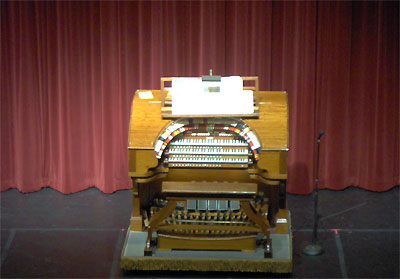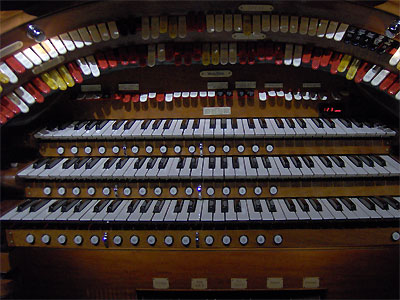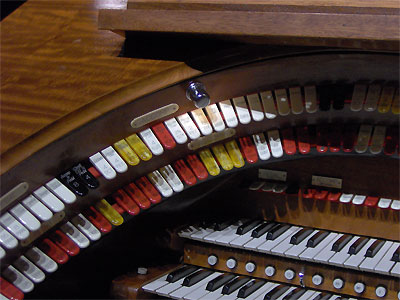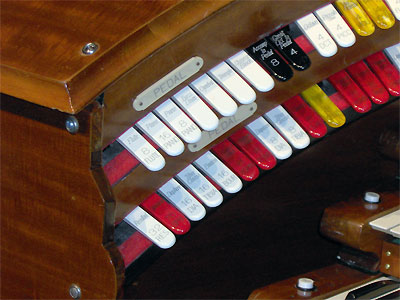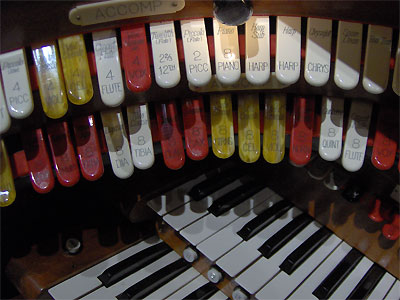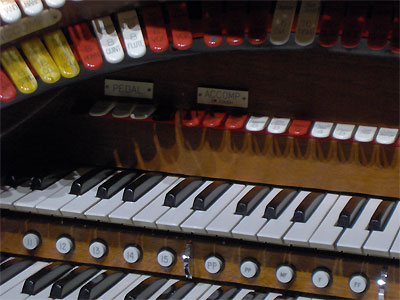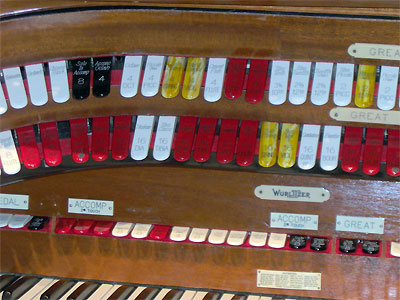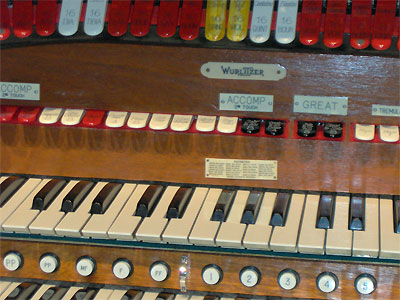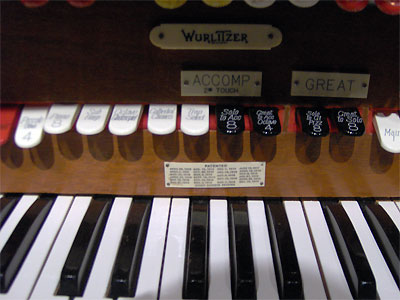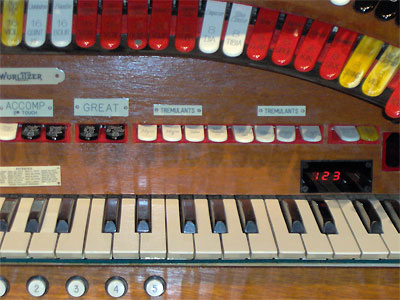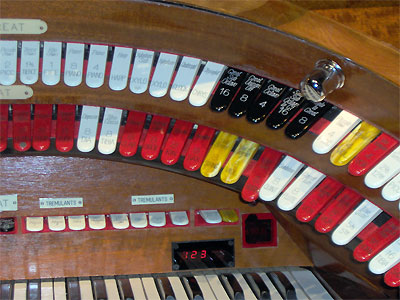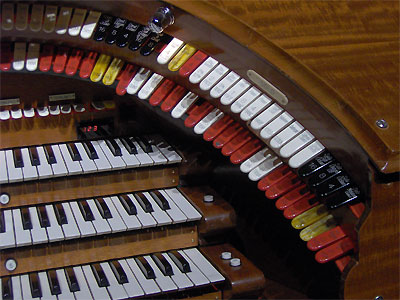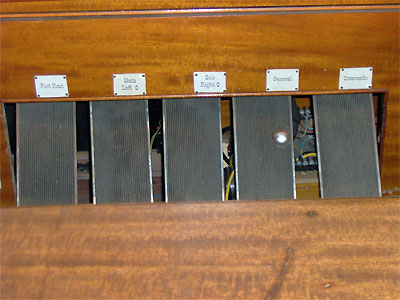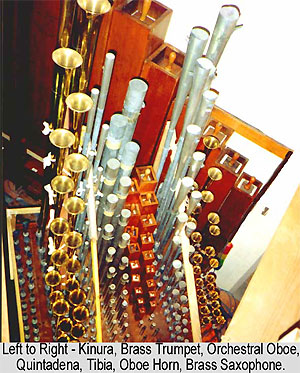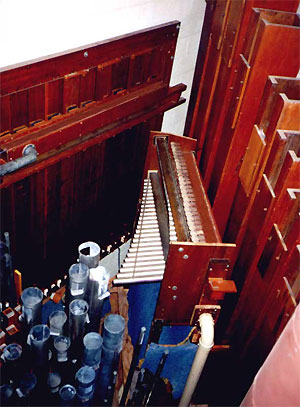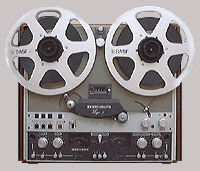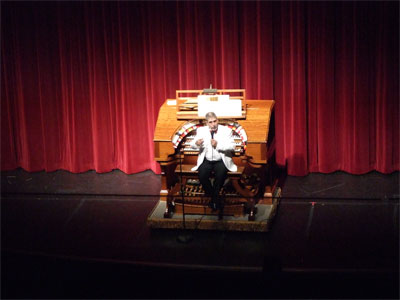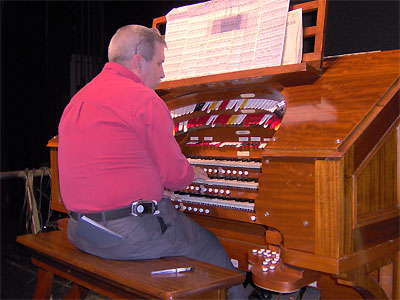
|
|
3/16 Mighty WurliTzer
|
||||
|
This month's featured organ is Miss Buckeye, a wonderful Style 260 3/16 Mighty WurliTzer Theatre Pipe Organ installed at the Thomas Worthington High School in Columbus, Ohio. The Mighty WurliTzer Style 260 Opus 1407 was originally installed in the Keith Albee Theatre, known now as the Palace theatre, in downtown Columbus, Ohio in 1926. The performances and attractions on the opening night included silent films accompanied by the Mighty WurliTzer and also several other stage shows. Of course, shortly after opening night, the "Talkies", or movies with sound as we know them today, came out and the organ fell silent for several years. A local dairy businessman named Tom Hamilton started saving organs around town. Tom, Bill Hunt and Frank Babbit, along with a few other dedicated volunteer helpers, started restoring the Mighty WurliTzer at the Palace. They spent many evening and nights cleaning parts and releathering, etc. In 1968, Tom approach the owners of the Palace Theatre and asked them if they would like to sell the organ. Come to find out, the owners were already in talks with COSI to purchase the instrument. Although work continued through 1969, the deal fell through with COSI. Tom was approached with a deal from the Palace Theatre and the negotations continued on. Tom finally came to a agreement and purchased the instrument. All this was going on during the same time Tom Hamilton, Frank Babbit, Carlos Parker and several others were saving the Loews Theatre, now known as The Ohio Theatre.
COTOS members at the time began removing the organ from the Palace Theatre and moving it down to a warehouse, where Willard Ebner and others began a complete restoration of the instrument while they continued to look for a home for the Mihtgy WurliTzer. In 1974, they found out that the Thomas Worthington High School was planning to build a new auditorium, so Frank Babbit and Tom Hamilton approached the school board. Mary Hottenroth gave a large donation to the cause. A proposal was filed and everyone was most intrigued, agreeing to build two chambers and a relay room in the planned auditorium. Late in 1975, the process of installing the organ bagan at Thomas Worthington High School. The school has used the organ several times through out the 32 years it has been there. Today, COTOS is in the middle of a fund drive to aquire the money needed to finish the job of restoring this wonderful organ. -Tom Yanitell |
||||
A Closer Look at the Console |
||||
|
We are greatly indebted to Tom Hoehn and Tom Yanitell for providing these pictures and recordings of this fine instrument for you to enjoy.
In the picture above, we see the left stop bolster of the horseshoe containing the Pedal and Accompaniment stops. Note the empire styling of the console, with the straight ogee edge along the edge of the horseshoe lid, accented by the little chrome-dome stop rail lamps. This console is simular to the J. Tyson Forker Memorial 4/32 Mighty WurliTzer Theatre Pipe Organ in Sarasota, Florida.
Here, we get a close up view of the Pedal stops in the left bolster of the horseshoe. Note the single String Celeste in the Pedal. Note also the 32 footers, which are resultants derived from the three 16 foot offset chests upwards at 16' and 10-2/3' pitches. As we move to the right around the horseshoe, we come to the Accompaniment stops. Note the five String Celestes, making this manual capable of some very lush background tones. Below the Accompaniment stops in the horseshoe can be found the Pedal and Accompaniment stops that would not fit in the bolster, therefore, they are on the fallboard below the stop rail. These include several Accompaniment first and second touch stops.
Moving further to the right, we come to the Great stops. Below these stops are the overflow Accompaniment stops on the fallboard. You can plainly see the second touch group, along wiht the two Great couplers to the right of the Accompaniment second touch stops.
Here, we see the bottom row of Great stops with the Accompaniment overflow stops on the fallboard below. Note that there are nine String Celestes and a treasure trove of colour reeds for thousands of possible combinations of beautiful orchestral tones.
Below the overflow stops on the fallboard, we see the Patent Pending plate containing the many patent numbers the WurliTzer Company filed applying to this instrument.
Moving further to the right, we see the many Tremulant stops and the digital LED clock on the fallboard below the bottom row of Great stops. To the right of the clock is the memory level display for the electronic solid state Moving Combination Action.
Looking up a bit we see the rest of the Great stops in the right curve of the horseshoe. This instrument is heavily unified, so most of the voices are available at at least three pitches without couplers. There are couplers in each division for sub, unison off, and octave.
As we come to the right side of the horseshoe, we find the Solo stops. Notice the large number of Reeds and the two String Celestes. This manual means business with its firey Post Horn and stately Trumpet, along with Tuned Percussions galore.
Looking below the keydesk, we see the five pedals that control the swell shades and crescendo. Note that the left-most of these pedals is only there for one to rest a foot on, as it is not hooked up to anything. |
||||
Organ Specifications
Three manual Style 260, Opus 1407. |
||||
|
|
||||
|
||||
|
|
||||
|
||||
Free Music Downloads |
||||
Tom Hoehn at the console of the
|
||||
About The Music |
||||
|
Tom Hoehn played this music on April of 2007. The recording was made using his Samson Zoom H4 digital audio recorder like the one we use at the Walnut Hill Office of Operations. To see a picture of this versatile little machine and read about it in greater detail, click here and scroll down to the "About The Recordings" topic in the February 2007 Featured Organ of the Month page. |
